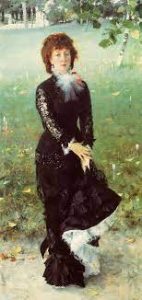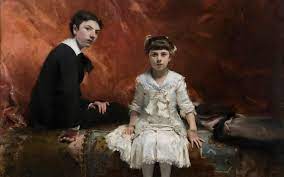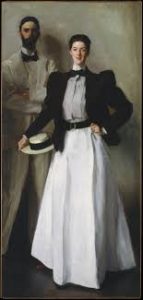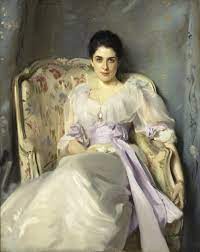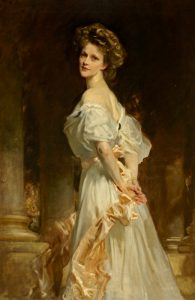John Singer Sargent – The Power of the Portrait – a lecture by Alexandra Epps
Alexandra began her fascinating lecture by giving us a brief introduction to Sargent – that he was the leading portrait painter of his generation – painting in total 900 portraits. Everyone wanted to be painted by him. As a painter he wanted to create beauty. Alexandra said she was using his portraits to take us on a journey from 1856-1925.
He was born in Florence of American parents and his wish to keep his American citizenship meant that he turned down a knighthood. He was publicity shy and found social gatherings quite a challenge.
In 1874 aged 18 he arrived in Paris for a more academic artistic training. He became a star pupil. HIs painting of Carolus Duran – his teacher – gives us a really good sense of the man.. Note the position of the hand.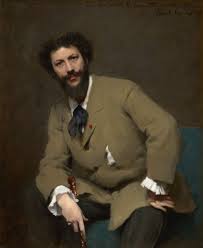
His portraits are life size and so will take up considerable space.
In 1879 he painted Madame Edouard Pailleron and it is clear he paints as he saw and did not set out to flatter. Note the whiteness of the face and the expression which contrasts so sharply with her coquettish position.
In 1881 he painted Madame Ramon Subercaseaux the wife of the Chilean Ambassador to Chile – depicting beauty and gaining him high regard in Parisian society.
IN 1882 he painted Lady with a Rose in which the neutral background projects the lady forward. Again the gesture of the hand on the hip is also something to note.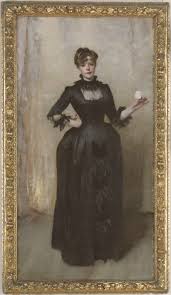
His first double portrait of the Pailleron children , whilst reinforcing his standing as a portrait artist caused him endless grief attempting to work with the rather belligerent daughter – who became a writer in later life and wrote about her catastrophic battle with Sargent . Again Sargent shows emotions of the sitter by the position of the hands.
In 1882 he painted the daughters Edward Darley Boit in which there appears to be no relationship between the girls and the older girls seem to be retreating into the shadows . There positioning is very geometric compared to the vases and there is an air of Alice in Wonderland. 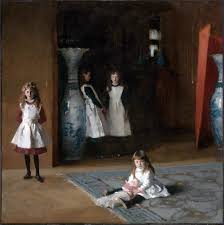
Sargent then paints a portrait of Virginie Gautreau This was not a commission but a request by Sargent to paint her – he is very proud of this painting but society is shocked by the revealing dress and the jewelled straps ( one of which in the original painting was hanging below her shoulder ). The pose was carefully chosen with the body facing forward but the head turned in profile. Sargent defended the painting by saying he painted as he saw her. Note the tension in the arms and neck The scandal caused him to try to conceal the name of the subject by calling it a portrait of Madame X but the scandal rocked his popularity and unnerved him and sargent left Paris for Broadway in the Cotswolds and joins an artists’ colony.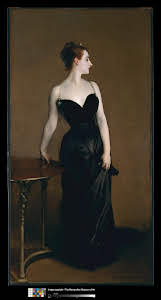
In 1886 he paints Carnation Lily lily Rose. 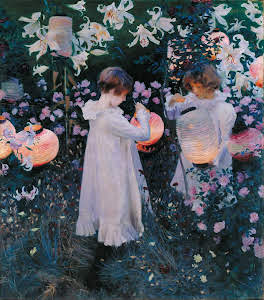
He captures the moment – making us feel as if we are actually in the canvas. The girls appear so serene ( whereas in fact as the evening was drawing on they were getting colder and colder ) Note how the light from the lantern is playing on the face of the girl .
In 1888 he was asked to go to America to Boston to paint Isabella Stewart Gardner and she becomes a friend of Sargent 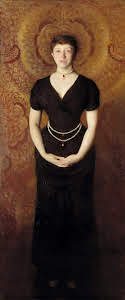
the background gives her a halo. This painting was never put on public display display until her and her husband had died.
In 1897 he painted Mr. and mrs Isaac Newton Phelps Stokes. It is interesting to note how the husband appears to be in the background – it was originally intended to have their dog in the portrait but instead. the husband was included – almost as a pet
In 1888 he painted Alice Vanderbilt Shepard- using white to highlight her innocence
In 1889 he painted Ellen Terry as Lady Macbeth to dramatic effect.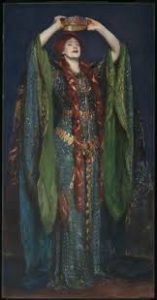
Back in London he paints Lady Agnew of Lochnaw Madame X contrasts sharply with this painting (1892) which shows how well Sargent can paint flowing fabrics such as tulle and satin. I was how everyone wanted to look – pale, iridescent and a relaxed posture . When it was exhibited in 1893 it was a smash hit and it helped to secure Sargent’s standing in Britain.
In 1892 he painted Mrs. Hugh Hammersley which displays a lot of nervous energy compared to the American portraits . note the position of the hands.
In 1899 his painting of the Wyndham Sisters displayed their affluence and entitlement – note the hands – with the flowers fabric etc. 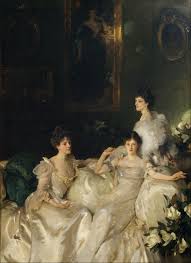
All the great ladies were lining up to be ‘Sargented’
In 1909 he had grown tired of this and painted a simple portrait of Nancy Astor.
He died aged 69
At the end of this most interesting lecture I think we all felt that we would have we would liked it to carry on longer and we most certainly felt that we knew so much more about the portraits of John Singer Sargent .
